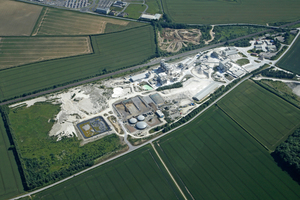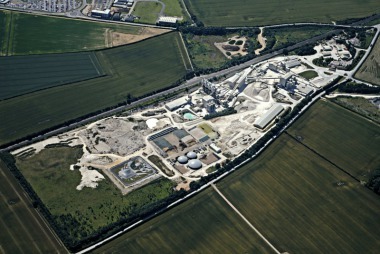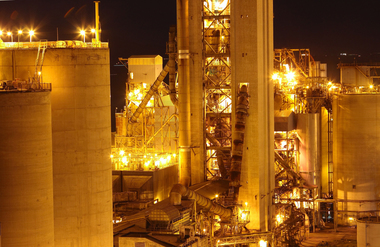Anaerobic Digestion (AD) for the lime industry 2.0 – the success story continues
The three biogas plants which Birch Energy owns and operates since 2014 continue to perform well and produce around 23 GWh/a electricity to meet the demand of the Singleton Birch lime works.
The UK-based lime company Singleton Birch Ltd. commissioned its first biogas plant in 2014, now operating three plants with a total electrical capacity of 3 MW. “The three AD plants that Birch Energy owns and operates all continue to perform well and produce enough electricity to meet the demand of the Singleton Birch lime works. Annual electricity generation is around 23GWh,” says Martin Haworth, Director of Birch Energy.
The AD plants sell surplus electricity to the national grid, and also receive government subsidies for the electricity produced. These benefits, alongside the efficient operation of the plants, ensure that the Birch Energy is very profitable.
Due to the increasing pressure worldwide the focus for new AD projects in many countries is moving more towards using bio-methane as a fuel for transport or industry and to reduce the CO2 footprint and the use of fossil fuels. Governments across Europe are putting in place plans to de-carbonise road transport which can be achieved with electricity for cars, but trucks are more difficult and bio-methane and hydrogen are more credible solutions.
At the same time measures are being introduced to regulate emissions and pollution of the environment, i.e.:
South Africa has introduced a fee for CO2-emissions of about 8.30 US$/t CO2
Dairy farmers in California must reduce the methane emission from their farms by 40 % by 2023
The EU classifies palm oil mills which do not treat their waste environmentally friendly as “high-risk” and is planning to phase out by 2030 in accordance with the Revised Renewable Energy Directive (RED II)
Not all countries have a system where the production of renewable energy is subsidised, for example through feed in tariffs (FIT) for the production of electricity. Therefore the use of purpose-grown crops, i.e. maize silage, is not an option for the production of biogas. However, biogas can be used as an alternative fuel and replace the “traditional” fuels, simultaneously utilising organic waste materials to reduce uncontrolled degradation and emissions. Suitable materials which are available in many parts of the world are:
Farm waste (slurry, manure etc.)
Waste from food processing, fish industry, slaughterhouses etc.
Waste from palm oil, sugar, starch industry etc.
Separated organic fraction of household/municipal waste
Any combination of the above is of course possible, depending upon availability.
In the lime industry, the increase in the price of EUETS carbon allowances (approx. € 29 in July 2019) also provides a potential opportunity to use bio-methane as a fuel for industrial processes such as lime kilns.
How biogas can improve the situation
Another point to consider is what kind of energy provides the biggest benefit. The biogas can be used in different ways:
The biogas can be burned directly to produce heat; the calorific value of biogas is about 50-60 % of that of natural gas, so a bigger gas volume needs to be combusted to achieve the same result (suitable i.e. for drying), therefore biogas can be used directly to replace fossil fuel
Alternatively the biogas can be combusted in a combined heat and power unit (CHP) to generate power; a by-product of the combustion is heat which can also be used for heating and drying purposes
A third option for the utilisation of biogas is the upgrade to natural gas quality, so it can be used in the same way, i.e. in kilns or as transport fuel. A by-product of the upgrading process is CO2, which, in some countries, has a higher value than natural gas itself
Some of the main influencing factors for the viability of a biogas plant, which have to be taken into consideration, are:
Availability of feedstock/organic material
Costs for energy, feedstock and logistics, i.e. for other fuels
Existence of Feed-in-Tariffs (FITs) for power or other subsidies, tipping fees, disposal costs for waste or fees for CO2 emissions
Singleton Birch is the first limestone company worldwide using biogas as a renewable energy source to reduce their CO2 footprint and make their operation more environmentally friendly, at the same time also making the whole operation more economical.
The three biogas plants which Birch Energy owns and operates continue to perform well and produce around 23 GWh/a electricity to meet the demand of the Singleton Birch lime works. The AD plants receive government subsidies for the electricity produced.
There are other limestone companies where opportunities to use biogas are currently being evaluated, i.e. a for a Malaysia-based limestone company that wants to use palm oil waste from a nearby palm oil mill to produce biogas and replace natural gas first in the dryer, later potentially also in the kilns.
Conclusion
Biogas can contribute significantly to make a limestone operation more environmentally friendly and viable by producing its own energy, reducing energy costs, reducing emissions and reducing uncontrolled disposal of organic waste, hence improving the image of the whole industry. It can also make operations more reliable due to increasing the independence from a potentially unreliable public supply of power and natural gas.
Due to the many different factors that can influence the feasibility of a biogas plant in the limestone industry and the varying conditions in different countries in the world, each case needs to be evaluated individually from case to case.
//www.planet-biogas.com" target="_blank" >www.planet-biogas.com:www.planet-biogas.com







